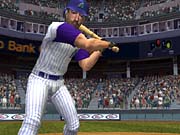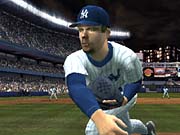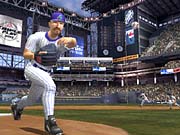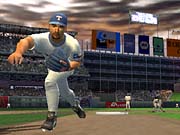Triple Play 2002
The next installment of EA Sports' baseball franchise for the PlayStation 2 is almost finished. Find out about the new additions in our hands-on preview.
EA Sports is about to roll out its Triple Play franchise for its second season on the PlayStation 2. We recently received a playable build of the game and it looks as if it will build upon the positive aspects of last year's outing while addressing its weak points as well. Last year's game on the PlayStation 2 was met with mixed reactions. While traditionalists bemoaned its homerun-happy gameplay, casual fans of the sport enjoyed the constant action. EA Sports has decided not to tinker with the formula too much, and instead has attempted to polish the existing game's mechanics and visuals.

Not much has changed as far as gameplay modes are concerned when comparing Triple Play 2002 to last year's game. The lone addition is the homerun derby where you and seven of your friends can try to drive as many balls as possible over the fence before getting 10 outs. Once again, there is no franchise mode included, but you can play seasons of 15, 30, 60, or 162 games. Statistics are tracked in nine categories for pitchers and 31 categories for most other players. Human players can control all 30 teams in the season mode, so if you have a large group of friends they can all get in on the action. And if you're unhappy with the current rosters in Major League Baseball, you can completely redraft the league to your liking. You may play the season mode on three difficulty settings, but if you want an authentic experience with less than 10 runs per game you'll have to play on the all-star setting. You can tweak the season settings to change the number of innings per game and whether there will be errors in the games. In addition to the homerun derby and season modes, you can also play head-to-head against one other person or go straight to the playoffs and play the number of games per series that you choose.

Playing Triple Play 2002 is not unlike playing past games in the series. The pitcher-batter interface has been slightly reworked to make it easier and to shorten the length of each game. Pitching is now accomplished with the press of a single button. First you choose the location of the pitch with the analog stick and then you must press the button that corresponds to the type of pitch you'd like to hurl. Batting is just as easy; you simply line up the batting cursor with the pitching cursor and time the swing. Batting cursors are sized based upon a hitter's ability, so Frank Thomas has an enormous cursor that almost fills the entire strike zone while pitchers like Curt Schilling have batting cursors only slightly larger than the baseball. EA Sports hopes that the alterations to the pitching interface will decrease the time it takes to complete each game by 33 percent, but the biggest improvement to the gameplay this time around is the replay buffer. After hitting the ball, the camera will switch to a fielding view where the ball will be shown being hit once again. This allows the fielder more time to prepare for the jump of the ball off the bat and eliminates the awkward camera transitions that cause missed ground balls in other baseball games. The feature works well, except in this current build, the hit will sometimes be shown several times, which can make it a bit difficult to anticipate when the ball is really going to be in play. This is likely to be fixed for the final version of the game. The AI for computer pitchers has also been adjusted so that there is some logic to their pitch selection. In last year's game the pitchers will randomly choose their pitches so that you will sometimes see them lead off with a changeup. In Triple Play 2002 the pitchers will set you up with a slider, blow it past you with a fastball, and then finish you off with an elbow-breaking changeup.

The same graphics engine from last year's PlayStation 2 game has returned with a few tweaks. The stadiums look magnificent with huge Jumbotrons that show the action on the field in real-time. Every last girder and seating section has been included in the stadium models and when you see fields such as Safeco for the first time you'll be amazed at how accurate they look. The lighting is also impressive. Shadows are cast on the field by the top of the stadium and they will slowly creep across the field as the game progresses. The graphical feature that EA Sports seems most proud of is the addition of more than 200 "cyberscanned" faces to the game. The faces look great and recent changes to player appearances have been included such as Randy Johnson's now-short haircut. Signature batting and pitching stances have also been reworked so that it's easier to tell Luis Gonzales from Mark McGuire without getting a look at their faces. Player models could still use some work as some of the larger players in Major League Baseball are still too small, but this is something that is still being worked on. Another new graphical addition to this year's Triple Play is the "big play moments" presentation. Not all that different from the game story that's included in EA's NHL franchise, when a game starts to get intense, the camera will focus on the pitcher and batter between each pitch. EA Sports hopes that this will provide some drama and excitement to a sport that is generally more subdued than others. Other small touches such as particle effects that are used to show dust kicking up, players piling up on the pitcher's mound after a win, and hit balls that will curve while in the air help to give the game some touches of authenticity. But other small graphical components such as sliding animations have yet to be fully implemented so it's difficult to get a handle on what the final product will look like in motion. Unlike its Xbox cousin, the PlayStation 2 version of Triple Play 2002 already runs with a smooth frame rate. In all, Triple Play 2002 for the PlayStation 2 is the best-looking baseball game on the system and should only improve as its release date gets closer.

EA Sports has decided to change the play-by-play commentator for this year's game and it couldn't have made a better choice. Bob Costas, considered by many to be the best baseball announcer in the business, does an excellent job of calling the game. His sentences never seem stilted or patched together, and just like watching a real game that Costas calls, the commentary is littered with insightful comments and sidebars. Costas' partner in crime is ESPN's Harold Reynolds and he does an excellent job of not going over the top while still keeping the atmosphere light. Ambient sound effects such as peanut vendors trying to drum up business have already included in the game, and despite a few occasional hiccups, the sound is already quite good.
Baseball purists were unhappy with the high scoring shenanigans of last year's Triple Play and it doesn't appear as if much has been done to change that. But if you appreciate some offense in your baseball video games, Triple Play 2002 has a great deal to offer. The player faces have been vastly improved, the playability has been increased thanks to the replay buffer, and Bob Costas is handling the play-by-play. While it's disappointing that there is no franchise mode, the season mode includes enough statistical tracking to keep most fans of the sport happy. Triple Play 2002 is currently scheduled for release in March. We'll have more information leading up to its release.
Got a news tip or want to contact us directly? Email news@gamespot.com
Join the conversation